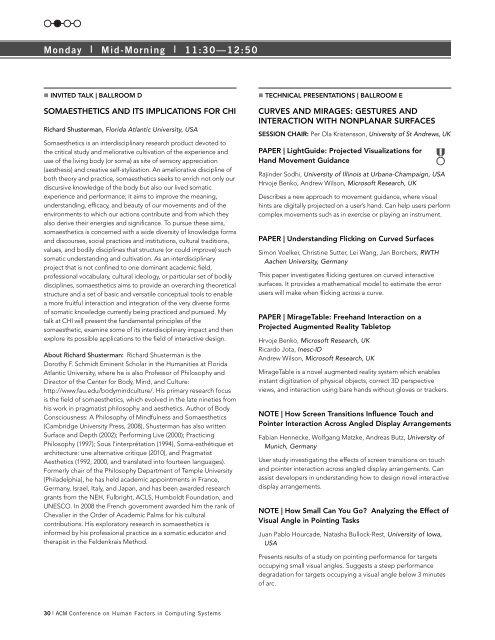Printed Program (pdf) - CHI 2012 - Association for Computing ...
Printed Program (pdf) - CHI 2012 - Association for Computing ...
Printed Program (pdf) - CHI 2012 - Association for Computing ...
You also want an ePaper? Increase the reach of your titles
YUMPU automatically turns print PDFs into web optimized ePapers that Google loves.
Monday | Mid-Morning | 11:30—12:50<br />
n INVITED TALK | BALLROOM D<br />
SOMAESTHETICS AND ITS IMPLICATIONS FOR <strong>CHI</strong><br />
Richard Shusterman, Florida Atlantic University, USA<br />
Somaesthetics is an interdisciplinary research product devoted to<br />
the critical study and meliorative cultivation of the experience and<br />
use of the living body (or soma) as site of sensory appreciation<br />
(aesthesis) and creative self-stylization. An ameliorative discipline of<br />
both theory and practice, somaesthetics seeks to enrich not only our<br />
discursive knowledge of the body but also our lived somatic<br />
experience and per<strong>for</strong>mance; it aims to improve the meaning,<br />
understanding, efficacy, and beauty of our movements and of the<br />
environments to which our actions contribute and from which they<br />
also derive their energies and significance. To pursue these aims,<br />
somaesthetics is concerned with a wide diversity of knowledge <strong>for</strong>ms<br />
and discourses, social practices and institutions, cultural traditions,<br />
values, and bodily disciplines that structure (or could improve) such<br />
somatic understanding and cultivation. As an interdisciplinary<br />
project that is not confined to one dominant academic field,<br />
professional vocabulary, cultural ideology, or particular set of bodily<br />
disciplines, somaesthetics aims to provide an overarching theoretical<br />
structure and a set of basic and versatile conceptual tools to enable<br />
a more fruitful interaction and integration of the very diverse <strong>for</strong>ms<br />
of somatic knowledge currently being practiced and pursued. My<br />
talk at <strong>CHI</strong> will present the fundamental principles of the<br />
somaesthetic, examine some of its interdisciplinary impact and then<br />
explore its possible applications to the field of interactive design.<br />
About Richard Shusterman: Richard Shusterman is the<br />
Dorothy F. Schmidt Eminent Scholar in the Humanities at Florida<br />
Atlantic University, where he is also Professor of Philosophy and<br />
Director of the Center <strong>for</strong> Body, Mind, and Culture:<br />
http://www.fau.edu/bodymindculture/. His primary research focus<br />
is the field of somaesthetics, which evolved in the late nineties from<br />
his work in pragmatist philosophy and aesthetics. Author of Body<br />
Consciousness: A Philosophy of Mindfulness and Somaesthetics<br />
(Cambridge University Press, 2008), Shusterman has also written<br />
Surface and Depth (2002); Per<strong>for</strong>ming Live (2000); Practicing<br />
Philosophy (1997); Sous l’interprétation (1994), Soma-esthétique et<br />
architecture: une alternative critique (2010), and Pragmatist<br />
Aesthetics (1992, 2000, and translated into fourteen languages).<br />
Formerly chair of the Philosophy Department of Temple University<br />
(Philadelphia), he has held academic appointments in France,<br />
Germany, Israel, Italy, and Japan, and has been awarded research<br />
grants from the NEH, Fulbright, ACLS, Humboldt Foundation, and<br />
UNESCO. In 2008 the French government awarded him the rank of<br />
Chevalier in the Order of Academic Palms <strong>for</strong> his cultural<br />
contributions. His exploratory research in somaesthetics is<br />
in<strong>for</strong>med by his professional practice as a somatic educator and<br />
therapist in the Feldenkrais Method.<br />
30 | ACM Conference on Human Factors in <strong>Computing</strong> Systems<br />
n TECHNICAL PRESENTATIONS | BALLROOM E<br />
CURVES AND MIRAGES: GESTURES AND<br />
INTERACTION WITH NONPLANAR SURFACES<br />
SESSION CHAIR: Per Ola Kristensson, University of St Andrews, UK<br />
PAPER | LightGuide: Projected Visualizations <strong>for</strong><br />
Hand Movement Guidance &<br />
Rajinder Sodhi, University of Illinois at Urbana-Champaign, USA<br />
Hrvoje Benko, Andrew Wilson, Microsoft Research, UK<br />
Describes a new approach to movement guidance, where visual<br />
hints are digitally projected on a user’s hand. Can help users per<strong>for</strong>m<br />
complex movements such as in exercise or playing an instrument.<br />
PAPER | Understanding Flicking on Curved Surfaces<br />
Simon Voelker, Christine Sutter, Lei Wang, Jan Borchers, RWTH<br />
Aachen University, Germany<br />
This paper investigates flicking gestures on curved interactive<br />
surfaces. It provides a mathematical model to estimate the error<br />
users will make when flicking across a curve.<br />
PAPER | MirageTable: Freehand Interaction on a<br />
Projected Augmented Reality Tabletop<br />
Hrvoje Benko, Microsoft Research, UK<br />
Ricardo Jota, Inesc-ID<br />
Andrew Wilson, Microsoft Research, UK<br />
MirageTable is a novel augmented reality system which enables<br />
instant digitization of physical objects, correct 3D perspective<br />
views, and interaction using bare hands without gloves or trackers.<br />
NOTE | How Screen Transitions Influence Touch and<br />
Pointer Interaction Across Angled Display Arrangements<br />
Fabian Hennecke, Wolfgang Matzke, Andreas Butz, University of<br />
Munich, Germany<br />
User study investigating the effects of screen transitions on touch<br />
and pointer interaction across angled display arrangements. Can<br />
assist developers in understanding how to design novel interactive<br />
display arrangements.<br />
NOTE | How Small Can You Go? Analyzing the Effect of<br />
Visual Angle in Pointing Tasks<br />
Juan Pablo Hourcade, Natasha Bullock-Rest, University of Iowa,<br />
USA<br />
Presents results of a study on pointing per<strong>for</strong>mance <strong>for</strong> targets<br />
occupying small visual angles. Suggests a steep per<strong>for</strong>mance<br />
degradation <strong>for</strong> targets occupying a visual angle below 3 minutes<br />
of arc.


